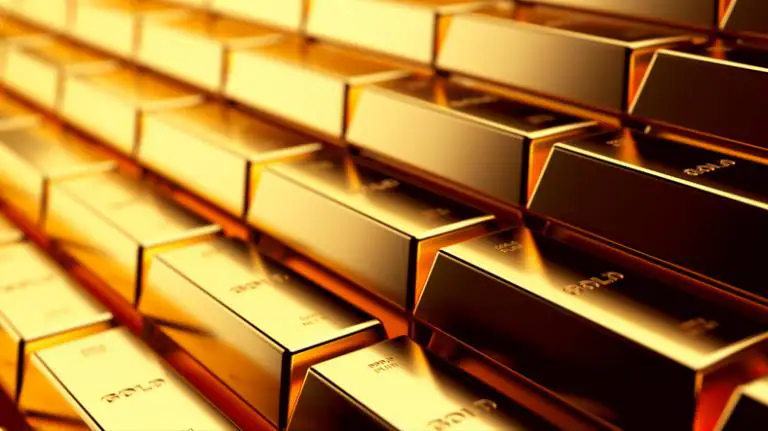
Introduction to Commodity Markets: Gold
Gold is one of the most widely traded commodities around the world and certainly the most popular of the precious metals, for both its financial and cultural value. It comes in several forms, including bullion and coins within the commodities market, stocks and ETFs in the share market, and even as a currency. Continue reading to discover what moves gold prices, who are the biggest producers in the world, and how to get involved with the yellow metal through our derivative products such as spread bets and CFDs.
Gold comes in the form of bullion, currency, spot and futures prices
It’s often referred to as a “safe haven” due to its resilience against market downturns
China, Russia, and the US are the world’s biggest producers
Prices are affected by interest rates, inflation, the US dollar, and supply and demand
You can trade derivatives on spot and underlying futures prices
What is the gold market?
Gold was first used as currency since the Byzantine Empire (395–1453AD), most notably the pure gold coin the Byzantine solidus.
More recently, gold was used as the world reserve currency up until 1971, when the US abandoned the gold standard. Before then, the value of a country’s currency was directly linked to the value of gold.
Rather, paper money had to be backed up by an equal amount of gold in a country’s reserve, which in most cases was gold bullion.
The value of gold
Historically, the commodity’s price has fluctuated often depending on political, social and economic instability. It’s sometimes referred to as a ‘safe haven’ by traders because, unlike most shares in the stock market, its price is not always affected by governmental decisions or inflated by interest rates.
On the contrary, the precious metal can act as a form of insurance, as traders might reallocate assets into the market at unstable times. This could increase its value, since demand might rise as traders attempt to use the metal as a stock hedge. It’s priced in US dollars and tends to have a negative correlation with stocks and bonds, depending on the stability of the economy.
When their share positions are declining in value, some traders decide to take a chance on gold trading to balance out their potential losses. This way, traders are attempting to diversify their portfolio as they spread their bets across a range of markets.
You can speculate on our gold cash price, along with other precious metals such as silver and platinum, so view our spreads, margin rates, and prices below to get started.
How is gold different from currencies?
So is gold a commodity? A currency? Or a combination of the two?
The free market system we currently trade in (post-gold standard) allows gold to act very similarly to a currency.
Gold is not often used for direct payments; however, it is highly liquid and can be converted to cash in most currencies very simply.
That said, gold is, first and foremost, a commodity often grouped with other precious metals, such as silver, platinum and palladium.
Gold is a global commodity and can be traded in many currencies. However, the typical market quote is to price gold in "US dollars per troy ounce".
This relationship to the US dollar is one of many important factors that influence the price of gold, which we’ll now take a look at.
What factors impact the price of gold?
Unlike oil or coffee, for example, gold isn't consumed (although sometimes chefs get bored with edible ingredients and add them in). Also, as it is virtually indestructible, most of the gold that hase ever been mined is still around to this day. As such, the price of gold is moved more by a combination of supply and demand, and investor behavious.
Nowadays, when other investments seem too risky, gold is often seen as a "safe haven".
It generally performs well during global crises such as wars, terrorist attackes, and pandemics, to name but a few, as it is seen as an attractive hedge.
For example, if the US central bank, the Federal Reserve, decided to cut interest rates, this would usually weaken the US dollar and lift the price of gold.
It's therefore important when trading gold to keep an eye out for any major economic announcements that could impact inflation - and in turn gold - such as unemployment figures, interest rates, price changes in energy or food, and even natural disasters.
Why do people trade gold?
Hedge against inflation:
Inflation occurs when the value of a currency, say the US dollar, decrease over time whilst the price rises. Some traders will store some of their wealth in gold to counteract this trend as gold, unlike currency, is a finite resource.
Safe haven:
Gold has a reputation as a safe investment, therefore it tends to do well when other asset classes, such as stocks are doing poorly.
Currency proxy:
Gold Prices are often used to measure the relative value of a local currency and can be traded as a substitute for currencies in some situations.
Ways to trade gold?
Spot Gold:
Gold is an over-the-counter asset, with
70% of global gold trading
being physical, via the London Bullion Market Association. Whilst hefting gold bars between vaults may not sound particularly practical, most of these members are international banks, bullion refiners and dealers.
Gold futures and options:
another way to trade gold is via futures and options contracts. The biggest exchange for gold futures (code: GC) is the COMEX section of Chicago Mercantile Exchange (CME), which offers electronic trading virtually 24 hours a day. The contract size is 100 troy ounces (3.11kg). As gold is used around the world, it is traded on almost all stock exchanges around the world.
Investing:
investing in shares or exchange traded funds (ETFs) is an easy way to get exposure to gold. For leveraged exposure to the gold price, you can purchase shares in gold companies and miners listed on any securities exchange. Alternatively, you can buy gold ETFs which track the value of the underlying commodity.
Trading via CFDs:
Another option is to trade Gold CFDs (contracts for difference). To put it simply, this allows traders to buy or sell positions in a financial instrument, exposing them to movements in the gold price without physically purchasing the commodity.
How to trade gold
Open an account with CMC Markets.
Choose between a
live account
to get started straight away or practise with virtual funds on our
demo account
Deposit funds into your account.
Remember that CFDs are leveraged products, so you will only need to deposit a small percentage of the overall value of the trade. Profits and losses will be based on the overall value of your position.
Research the best time to trade gold.
Certain political and economic events can have an effect on the price and volatility of the commodity market. This means that the risk of gold investment can either pay off or cause serious losses. Use our
page to keep aware of any changes to the gold market that may affect your trade.
Monitor price movements.
Keep up with the latest trends of your gold trade online using our range of our technical indicators.
Think about your risk management strategy.
Consult our money and risk management guide in order to place the appropriate measures in your trading strategy. We advise all of our clients to consider using a
to reduce their losses to the absolute minimum.
Gold stocks
You can also trade CFDs on a wide range of gold stocks within the share market, instead of investing in physical gold. This is an effective way to gain exposure to the underlying asset without physically owning the gold product. At CMC Markets, we offer over 8000 stocks and ETFs to trade on a worldwide level on our online trading platform.
Traders should open a position based on whether they think the share price of the gold company will rise or fall, and subsequently profit or lose based on which direction the price movement heads. Below is a list of some of the largest gold mining stocks right now.
Barrick Gold
– this Canadian company has headquarters in Toronto and is one of the largest gold mining companies in the world, previously sitting at the top spot before 2018. It is estimated to produce approximately 141 tonnes of gold each year. The company has merged assets based in Nevada, USA, with rival gold company Newmont Goldcorp, as well as acquiring other smaller gold mining companies within recent years.
Franco-Nevada
– this company is also based in Toronto, Canada, and is a leader in gold streaming and royalty. Franco-Nevada pays a healthy dividend and has consistently steady balance sheets, making it a great gold stock to invest in. The company covers gold, silver and other precious metals, as well as oil and gas, although the majority of its revenue comes from gold.
Petropavlovsk
– one of Russia’s major gold mining companies, Petropavlovsk also has offices in London and accounts for a small part of the FTSE 250 stock index. The company claims to have advancements in production, reserves and resources, with the aim of offering a responsible and low-cost output of gold.
Newmont Goldcorp
– this company currently ranks first in the world as a gold supplier. It has mining operations in five continents, which amounts to approximately 180 tonnes each year. Newmont Corporation acquired the Canadian company Goldcorp in 2019, merging the two gold suppliers together to become Newmont Goldcorp.
Newcrest Mining
– Australian-based company Newcrest Mining apparently has the largest group gold ore reserves in the world, which makes it one of the top gold stocks. It focuses on the exploration, development and sale of gold across four countries.
Gold ETFs
An exchange traded fund* (ETF) is a type of investment fund that holds a collection of underlying assets, including shares of a company, to give an investor exposure to this asset, which in this case would be the commodity. Gold ETF trading is a low-cost investment choice that can be bought and sold like any other share in the stock market.
ETFs give traders the opportunity to diversify their portfolio by investing in a number of gold shares, rather than a singular one. Below is a list of the main gold ETF competitors to trade on our platform.
SPDR Gold
– this is the largest and most popular physically backed gold ETF in the world, and it can be traded on a number of stock exchanges around the world. It seeks to reflect the performance of gold bullion’s price. This ETF is often used for hedging against volatility of other markets, including forex and stocks.
iShares Gold Trust
– this exchange-traded fund seeks to reflect the price of gold in general. It has one of the lowest expense ratios for gold ETFs, which is attractive for investors that are conscious of extra costs.
Aberdeen Standard Physical Swiss Gold Shares
– also issued to reflect the performance of the price of gold bullion, this ETF is designed to be cost-effective and convenient, as an alternative to purchasing and storing gold directly.
Gold market overview
Over many centuries, the gold trade has seen it all. Empires have risen and fallen, economies have prospered and crashed and though demand has waxed and waned, there has always been a market for gold. This is why many see it as a safe haven investment. Still, like every other investment, its prices will fluctuate over time – which creates opportunities and risks for traders.
However, gold is just one of a number of options open to commodities traders, with many preferring to focus on oil, grains or coffee. To find out more visit CMC’s Commodities Market.

Introduction to Commodity Markets: Oil
Oil trading is the process of buying and selling crude oil, one of the most actively traded commodities in the world. A raw material that is commonly extracted from Middle Eastern countries, it is referred to as “black gold” and “the mother of all commodities”. It’s popular among traders due to its high volatility during times of geopolitical uncertainty, as well as a changing supply and demand largely driven by the OPEC cartel. Read on to discover how to trade with us within the commodity market.
Disclaimer: CMC Markets is an execution-only service provider. The material (whether or not it states any opinions) is for general information purposes only, and does not take into account your personal circumstances or objectives. Nothing in this material is (or should be considered to be) financial, investment or other advice on which reliance should be placed. No opinion given in the material constitutes a recommendation by CMC Markets or the author that any particular investment, security, transaction or investment strategy is suitable for any specific person. The material has not been prepared in accordance with legal requirements designed to promote the independence of investment research. Although we are not specifically prevented from dealing before providing this material, we do not seek to take advantage of the material prior to its dissemination.


